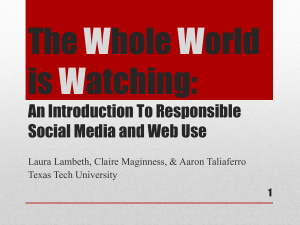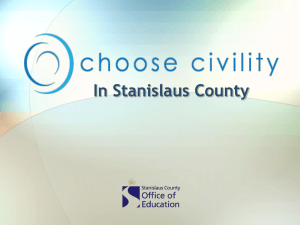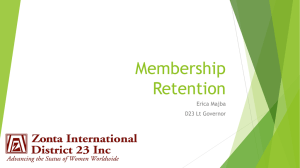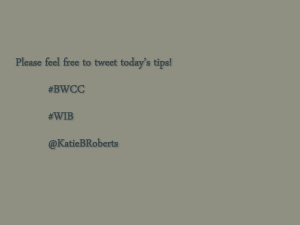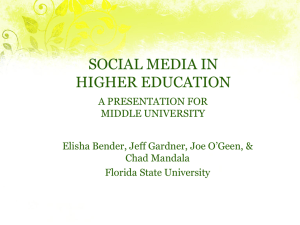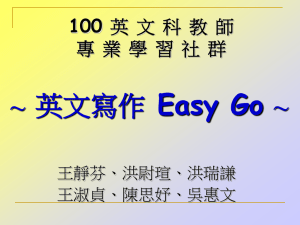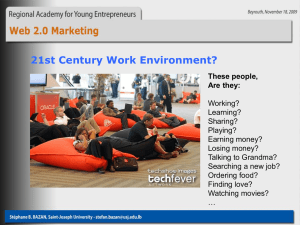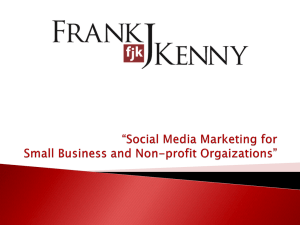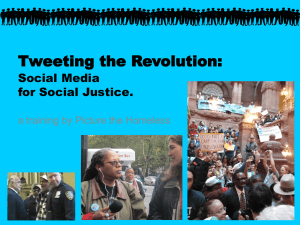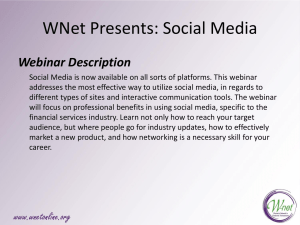Wright State University (Custer team)
advertisement
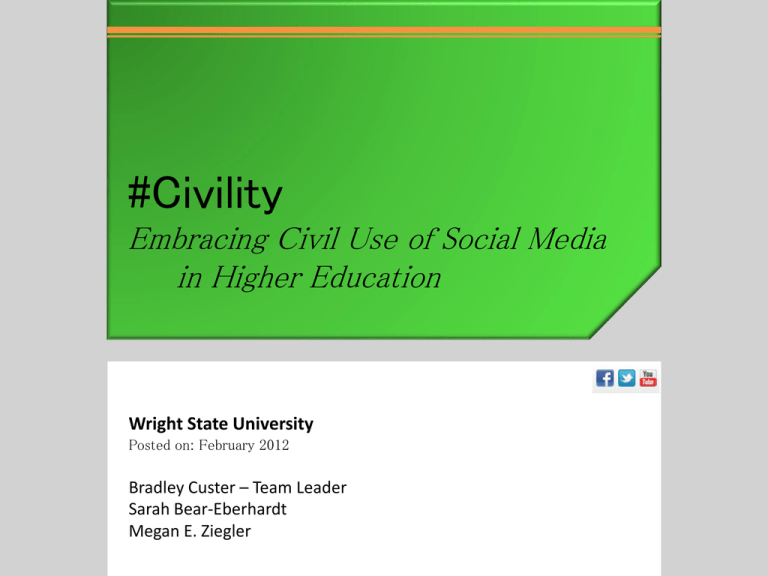
#Civility Embracing Civil Use of Social Media in Higher Education Wright State University Posted on: February 2012 Bradley Custer – Team Leader Sarah Bear-Eberhardt Megan E. Ziegler Overview I. Goals II. Examples of Social Media Use A. Education B. Business C. Student Affairs III. Best Practices IV. Positive Aspects of Using Social Media V. Application of Theory A. Chickering's Theory of Identity Development B. Baxter Magolda's Self-Authorship VI. The Civility Statement VII. 2 Case Studies VIII.Recommendations IX. References Goals • To promote the use of social media on campus with college leaders and provide positive examples of social media’s use in industry as well as in higher education. • To lay the groundwork for social media’s influence on student development by reflecting how Chickering’s theory of identity development and Baxter Magolda’s theory of self-authorship can be formed by students’ use of social media. • To communicate a civility statement and programming that promotes civility in a way which students will follow and one which college leaders will support. • To present two real-world cases which can be shared with students in the future and will demonstrate the consequences of making uncivil statements online. EXAMPLES OF SOCIAL MEDIA USE Social Media & Education The Social Media Dilemma 2011 Ron Schachter • • • • • • • • • 600 million Facebook users K-12 schools are beginning to incorporate social media because it is interactive, accessible and free! Some schools have banned it for fear of inappropriate use – others embrace it Principal at one school uses Facebook to communicate with parents Parent Teacher Student Association started a page on Facebook which doubled the membership School administrators use Twitter to advertise sporting events Superintendent uses twitter to communicate good news because no one reads newspapers anymore First-graders have a class Facebook page to post pictures and classroom activity updates Other school administrators use Twitter to announce bad weather, use googledocs, students create videos and upload them to YouTube, etc. Key points: We should use social media in higher education because students in k-12 are using it! College administrators can use social media to communicate with students, staff, parents, and community members. Social Media & Education Facebook: Challenges and Opportunities for Business Communication Students 2010 Christina Decarie • • • • In this article, a communication professor tells her story of her transition from uneasiness with Facebook to her use of it in her classroom “Facebook literacy is a necessary communication skill” Facebook “requires and enhances strong writing and intrapersonal communication skills” Professor shows students examples of poor writing and inappropriate language in status updates – students then evaluate them – They examine what affect poor Facebook posts might have on them if employers see those kinds of posts • “Social networking is not merely a way to waste time, but if used wisely, it is a means of self-representation and self promotion. As communication teachers, it is our responsibility to show them how.” Key points: Faculty recognize the importance of social media and are teaching students how to use it properly. Students can learn from their mistakes on social media. Social Media & Education YouTube Video Project: A “Cool” Way to Learn Communication Ethics 2010 Carol Lehman, et. al. • This communications professor describes a popular project using YouTube. • Project: students create an innovative training video on company ethics and upload it to YouTube • Students are already tech savvy enough to do these kinds of projects • They are reviewed in class and by a panel of business professionals • This media project gives students the opportunity to be engaged in a normally less-than-exciting course Key points: Professors are expecting students to use social media in the classroom because employers expect it. Students think social media is engaging and “cool”. Social Media & Business Shaking Things up at Coca-Cola 2011 Harvard Business Review, Adi Ignatius • Coca-Cola’s new CEO, Muhtar Kent, wants to double sales by 2020, and he is using social media to do it. • 33 million Facebook fans – a page not even created by Coke • Largest single product page on Facebook • Coke spends 20% of its media budget on social media • Question: “What’s the value exactly of those 33 million Facebook fans?” Answer: The value is you can talk with them. They tell you things that are important for your business and brands. Today consumers are buying products not just for the quality but also because they believe in the character of the companies that produce those products. Key points: Large corporations are using social media in a big way to sell and to promote their products. College students must learn how to use social media. Social Media & Business Using Social Media to Grow Your Business 2010 Areg Bagdasarian and Steffanie Tamehiro • • • • • • • “Businesses can best benefit from social media by having a good overall strategy and knowing how to listen, participate, and measure results.” Budgets for social media in companies are increasing by as much as 79% Ford unveiled a car on Facebook instead of a car show Three methods for using social media in business: Listening – what’s being said about your company Location – finding the right sites to advertise on Participating – allowing fans and customers to interact with the social media, post pictures of them in their products (i.e. pictures of your kids in Baby Gap clothing) – – – – • Blogging Social networking sites Microblogging (Twitter Tumblr) Multiples (facebook + twitter, etc.) 1 in 5 small business owners are incorporating social media Key Points: Businesses need to be using social media to understand their customers and to engage them Social Media & Business Growing Popularity of Social Media and Business Strategy 2010 Lee Dong-Hun • Social media is the “open media for interactive communication led by normal people.” • 4 key values of social media for businesses – Speed and durability – post information immediately and it lasts forever unlike mass media – Audience: Plurality and diversity – transcends nationality and class – Cost: Feasibility and Effectiveness – most are free, low cost target group ads – Relations: Friendliness and credibility – interactive, participation • “Social media is broadly use by 79 percent for Fortune 100 Best Companies” Key Points: Successful students who can use social media for marketing will be desirable to business employers. Social Media & Student Affairs Serious Social Media: On the Use of Social Media for Improving Students’ Adjustment to College 2012 David DeAndrea, et. al. • • • • Author studied social media project that connected first-year students that studied a group of 265 incoming students using student-only social Author uses Bandura, social cognitive theory, non-student development theory to interpret results Students took pre and post test evaluating the student’s perceptions of connectedness Results showed that students were eager to help each other through the turbulent, pre-college period using this medium by posting helpful information about resources, orientation, perceptions of campus, etc. Key Points: The project getting students connected before they come to a college campus improves their perceptions of the college and social environment is important for college students BEST PRACTICES Best Practices • Social media are defined as any online forum where individuals can share personal information, photos, videos, and are highly and publically accessible. Examples of such are as follows: Facebook, Twitter, LinkedIn, YouTube, Google+, and many more exist. • The following list is to serve as a guideline of practices when engaging in a social media environment, and is applicable to all university officials and students: 1. Think before you blink: This slogan was crafted with the idea that anything can be posted within the blink of an eye. Even when mistakes are made, and you try to delete posts, the information you posted could have been accessed by anyone who has access to your “page.” That information could be forwarded and posted for the expansive internet audience to see without your knowledge or approval. There is relatively little privacy on the internet, and when we post pictures or comments that may be less than favorable, they are extremely hard to remove completely from the internet. If you wouldn’t say something or show something to your boss, you shouldn’t post it online. Best Practices, continued 2. Who says that?: Before posting anything online, check its accuracy. False information can cause problems for you and those who read the false information. Recognize that falsification of information and academic integrity policies do exist within the college’s Student Code of Conduct. 3. R-E-S-P-E-C-T: People will always have contentious points of view. Rather than poke the bear, encourage respectful discussions of opposing viewpoints. When all else fails, remember to treat others as you wish to be treated. 4. Who’s there?: Just because you can’t see them, doesn’t mean they aren’t there. Who?, you might ask. Your professors, your boss, your future employers, and your peers. You never know who might see what you post, so think about potential audiences before you click that mouse button. 5. In MY opinion…: Make sure that you are clear about whose opinions you are posting. Your opinions should always be stated as such, and there should be no possible way someone could interpret your opinions to be that of MC. POSITIVE ASPECTS OF USING SOCIAL MEDIA Positive Aspects of Using Social Media Junco, et al (2011) conducted a study that investigated the effect of using Twitter in the classroom and on student engagement. They found that • students were more likely to communicate with faculty and other students through Twitter than they were in-class and through a Classroom Management System (CMS). • Twitter created a cohort effect and connections with peers that they otherwise would not. • students were much more likely to create study groups using Twitter to arrange time and locations than the students limited to the CMS. • students shared values and interests with each other, and • students engaged with faculty far more than those limited to the CMS. Junco and Chickering (2010) state that “it is important for student affairs professionals to provide programming that helps students think critically about online information, engage in civil discourse, and focus on privacy issues. By doing so they will reinforce this learning throughout the students’ college experiences” (p. 18). THEORY AND SOCIAL MEDIA Chickering's Theory of Identity Development: The Seven Vectors of Student Development Developing Competence • This vector includes helping students cultivate their intellectual capacity, physical abilities, and interpersonal skills. While educating students on the civil use of social media may not lead to increased physical abilities, it certainly can add to expanding their knowledge base and most certainly can help develop their interpersonal skills in the online environment. Managing Emotions • Evans, Forney, Guido, Patton & Renn (2010) identify this vector as working with students to “develop the ability to recognize and accept emotions, as well as appropriately express and control them” (p. 67). In the past, this would have been useful in student’s face-to-face interactions. However, with the social media being used more often for communication, it has become increasingly important to show students how to react and respond in the online environment appropriately. Moving Through Autonomy Toward Interdependence • Using social media can greatly increase a student’s ability to “stand on one’s own feet,” because this is really a space for them to share their own feelings and thoughts. However, it needs to be stressed that once something is on the world wide web, it is there forever. Students need to have a greater sense of the gravity in which they are taking part. Chickering's Theory of Identity Development: The Seven Vectors of Student Development Developing Mature Interpersonal Relationships • Students feel a lot of pressure to be a part of social media, because it’s what “everyone’s doing.” During college, it will be critical, in order for a student to reach interdependence, that he/she understand there is another person on the other side of the screen and what they type or upload may have consequences. Establishing Identity • Again, using social media can be an excellent vehicle for not only getting the student to share his/her voice, but also the interconnectedness social media can provide by way of reaching out to individuals one may have never even met because they are in a different state or even a different country. Developing Purpose • From all of the learning that can take place by a student utilizing social media, it will be important for college professionals to frame their understanding in a way that is constructive for the student’s future interests and activities. Social media can expose students to a whole world which they never knew existed simply because of a tweet posted on another friend’s feed. It will be important for professionals to help students process this and support them in endeavors they may wish to undertake as a result of what they have seen or read while using social media. Developing Identity • Bringing together all the points from the previous vectors, this vector deals with the development of the student as a whole. Pulling all the experiences, reflections and thoughts of what the student has experienced in the online social media environment. Having gone through all these vectors will hopefully bring a culminating experience for the student where he/she has grown in their intellectual, intrapersonal and interpersonal skills. Baxter Magolda's Theory of Self-Authorship Phase 1: Following Formulas Social media is helping to create a more voyeuristic society, there has been an increase in the number of, what Baxter Magolda deems, formulas to which students are being exposed. Often these formulas can be conflicting, as they have always been, but there is a greater number of formulas students have available to them today because of social media. It is important to create an open dialogue where students can vent about what they are being exposed to and talk through the various pressures they are feeling. Phase 2: Crossroads The phase of Crossroads is when one “crosses” from being directed by the formulas from phase 1 to a more selfdetermined direction. This may be a difficult stage for students who heavily use social media where they are constantly being bombarded by other’s accomplishments. It will be imperative that college professionals work with students to develop their own voice. in the realm of social media. College professionals can help students identify who they are as individuals and how to deal with what they see online. Phase 3: Becoming the Author of One’s Life Social media can serve as a powerful tool for students to live out the story of their life. Social media sites can serve as platforms for students to not only verbally identify who they are and their beliefs, but also where they chronicle the events in their life that are helping to shape them. These sites can serve as a journal where students can reflect upon what they have written . Social media literally allows the student to become the author of their own life’s story. Phase 4: Internal Foundation If students are able to navigate through the previous three stages in the online environment, students will be more well-rounded and grounded in their beliefs and their life’s direction. Social media can be a powerful tool with proper guidance. PROMOTING CIVIL DISCOURSE Ways Middle College can Promote Civil Discourse • Implement “‘Social Spaces,’ a community conversation about social media” once a month (modeled after Campus Conversations created by the University of Idaho). This initiative will be teamhosted with participants from varying campus departments (both in Student Affairs and Academic Affairs). Social Spaces meetings are a proactive initiative designed to give students, faculty, staff and administrators the opportunity to come together and discuss implications of using social media. • Varying topics will be as follows: effects of posting negative comments/photos, networking through usage of social media, conducting effective civil discourse online, learning how exercising 1st Amendment rights can still be civil, and more. • Other topics of interest would be generated through these sessions. • This initiative will be conducted through several mediums: face-toface, Skype, and asynchronous video with live chat options. THE CIVILITY STATEMENT Background & Justification for a Civility Statement • • • While our approach is not policy, our approach incorporates the suggestions of Junco and Chickering (2010) from “Civil Discourse in the Age of Social Media.” Before implementing the following statement, a review of the College’s mission statement is necessary to ensure the college will be committed to supporting pluralism. The mission statement of the college and all departments (especially Student Affairs) within must reflect the college’s commitment to diversity initiatives. The civility statement – fosters open communication and sharing of multiple views. – recognizes that online forums are as important to student development as traditional forms of communication. – sets respect and civility as the mainstays of the statement. – is not policy; thus, there is no statement of sanctions for negative actions – supports initiatives for modeling positive interactions online. – includes a best practices statement. • It discusses identification of opinions so that personal opinion cannot be confused with MC’s opinion. – will be practiced by the whole community, but is monitored by the Student Activities Department within Student Affairs at MC. The Middle College Civility Statement* • • • Middle College (MC) defines civility as the practice of mutual understanding and respect that creates a positive environment for all members of our community. Civility should be practiced and demonstrated by faculty, staff and administrators as they are leaders within the MC community. They are to serve as models for our student body. Our students should also practice civility on and off campus as representatives of our great institution. We recognize the limitations of this statement, and cannot guarantee civic encounters at all times. However, the list below is to serve as a guideline in hopes that it will bring our community closer and create a safe environment for all. These guidelines should be practiced in person and electronically (through all forms of electronic communication, including but not limited to the following: social media—Facebook, Twitter, Skype, YouTube—email, listservs, classroom management systems). 1. 2. 3. 4. 5. 6. 7. 8. Consideration and respect for ideas, lifestyles and work of all individuals and groups Awareness of our actions and words in relation to campus life Practice civil discourse Fair and equitable treatment Understanding of and adherence to the MC mission statement Respect for the U.S. Constitution 1st Amendment rights Understanding of how harmful words, expressions and gestures affect those around us Enhancement of students’ ethical and moral development *Largely based on Ocean County College’s Civility Statement CONSEQUENCES FOR BEING UNCIVIL IN THE WORLD OF SOCIAL MEDIA: 2 CASE STUDIES Case Study #1 • Amanda Tatro, University of Minnesota mortuary science student, who posted on Facebook about playing with her cadaver and how she wanted to stab someone with an embalming tool. A discussion about how this student’s words reflect upon the university would follow. The University decided that Tatro violated student behavior policy, and was sanctioned to take an F in the course, undergo psychological evaluation, and academic probation. Tatro sued the University for violating her First Amendment rights, but the Minnesota Supreme Court upheld the University’s decision. – We wish to avoid turning the Civility Statement into policy as it leads to violations of students’ right to free speech. However, should we decide at a later date that the precedent has been set by University of Minnesota, we could revisit the possibility of changing this into policy. Please note, however, that speech codes have been ruled illegal by the U.S. Supreme Court on February 8, 2012, and would make any such policy difficult to enforce. The backlash from the publicity of such an event could be far more detrimental to the college’s image than the events of a case like this. Case Study #2 • A second example of negative consequences of not thinking before posting would come from Alexandra Wallace, UCLA student. She posted a video on YouTube that went viral within minutes. In her video, she complained about Asians on their cell phones in the library, used derogatory language to describe how they were speaking, and used racial stereotypes to complain about those who live in her residence hall. This caused such a backlash that she withdrew from the university and moved home, but not after her video was reposted multiple times (she deleted her original almost immediately, but copies are still accessible today on YouTube). – The college issued no sanction for her actions. UCLA determined that she did not violate their Student Code of Conduct, and that she was exercising her right to free speech. The student left on her own accord, but not before receiving hate mail and YouTube responses targeted towards her. She later issued a public apology. RECOMMENDATIONS Recommendations • Use and publicize the civility statement outlined • Create programing that educates students on positive, effective social media usage • Continue researching programs that work • Keep an open dialogue with students about how to best use social media and implications for its use References • • • • • • • • • “Alexandra Wallace Not Punished for Racist Rant” (2011). Huff Post Los Angeles. Retrieved from http://www.huffingtonpost.com/2011/03/18/alexandra-wallace-not-pun_n_837857.html Bagdasarian, A., & Tamehiro, S. (2010). Using social media to grow your business. Graziado Business Review, 13(4), n.p. Retrieved from EBSCOhost. Ball State University (2009). Ball State University Social Media Policy. Retrieved from http://cms.bsu.edu/About/AdministrativeOffices/UMC/WhatWeDo/Web/WebPolicies/SocialMedia. aspx DeAndrea, D., Ellison, N., LaRose, R., Steinfield, C., & Fiore, A. (2012). Serious social media: On the use of social media for improving students’ adjustment to college. Internet and Higher Education, 15, 15-23. Retrieved from EBSCOhost. Decarie, C. (2010). Facebook: Challenges and opportunities for business communication students. Business Communication Quarterly, 449-452. Retrieved from EBSCOhost. Dong-Hun, L. (2010). Growing popularity of social media and business strategy. SERI Quarterly, 112117. Retrieved from EBSCOhost. Evans, N. J., Forney, D. S., Guido, F. M., Patton, L. D., & Renn, K. A. (2010). Student development in college: Theory, research, and practice (2nd ed.). San Francisco, CA: Jossey-Bass. Iganatius, Adi. (2011). Shaking things up at Coca-Cola. Harvard Business Review. Retrieved from EBSCOhost. Johnson, Brett (2012). “Minnesota supreme court to rule on the off-campus speech rights of college students.” Student Press Law Center (SPLC). Retrieved from http://lib.westfield.ma.edu/webapa.htm References, continued • • • • • • Junco, R., & Chickering, A. W. (2010). Civil discourse in the age of social media. About Campus, 15(4), 12-18. doi:10.1002/abc.20030 Junco, R. R., Heiberger, G. G., & Loken, E. E. (2011). The effect of Twitter on college student engagement and grades. Journal of Computer Assisted Learning, 27(2), 119-132. doi:10.1111/j.1365-2729.2010.00387.x Lehman, C., DuFrene, D., & Lehman, M. (2010). YouTube video project: A “cool” way to learn communication ethics. Business Communication Quarterly, 444-449. Retrieved from EBSCOhost. Ocean County College (n.d.). OCC Campus Civility. Retrieved from http://www.ocean.edu/campus/PAR/civility.htm Schachter, R. (2011). The social media dilemma. District Administration, 27-33. Retrieved from EBSCOhost. University of Idaho (2012). Campus Conversations. Retrieved from http://www.asui.uidaho.edu/index.php?option=com_content&task=view&id=53&Itemid=66
